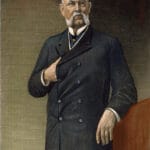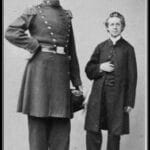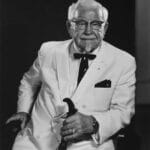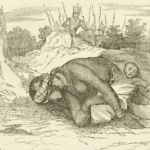Cornelius Vanderbilt III: Escaping the Shadow of a Dynasty
The year 1899 marked a pivotal moment for Cornelius Vanderbilt III. He wasn’t just handed his family’s immense fortune; he had to earn it, proving his capabilities after being initially cut out of his father’s will. This set the stage for a life defined by defying expectations and forging his own path.
While he could have easily lived a life of leisure, Cornelius III possessed a drive that went beyond inherited wealth. He was an inventor who secured over 30 patents, showcasing his innovative spirit. Among his creations were advancements in locomotive technology, like the corrugated firebox, and improvements to oil transportation with the cylindrical tank car. These achievements demonstrated his sharp mind and ability to succeed in his own right.
Cornelius III’s dedication extended beyond the realm of business. He served his country in the military, ultimately attaining the rank of Brigadier General. This commitment to duty illustrated his character and willingness to serve a cause larger than himself.
His life was not without its passions. Cornelius III shared his family’s love for the sea, becoming a skilled yachtsman and even participating in the defense of the prestigious America’s Cup in 1903. This connection to maritime pursuits showcased a different facet of his personality, revealing a man of diverse interests and talents.
In a bold move that demonstrated his independent spirit, Cornelius III went against his father’s wishes and married the woman he loved, Grace Graham Wilson. This decision spoke volumes about his character, emphasizing his commitment to love and personal happiness over societal expectations.
Beyond his personal achievements, Cornelius III understood the responsibility that came with his wealth. He played a pivotal role in the development of New York City’s first subway system and actively participated in charitable organizations. These actions exemplified his dedication to social good and desire to use his position to benefit others.
The story of Cornelius Vanderbilt III in 1899 is not merely one of inheritance but a testament to the power of personal ambition, innovation, and a commitment to making a difference. His life reminds us that true success is not measured solely by wealth, but by the impact we have on the world around us.
Cornelius Vanderbilt: Unveiling the Legacy of the Railroad Tycoon
Cornelius Vanderbilt, often referred to as “The Commodore,” wasn’t just a builder of railroads; he almost single-handedly shaped the American railroad system. Beginning his career with ferries, Vanderbilt quickly recognized the transformative potential of railroads, pursuing this vision with unwavering determination. He strategically acquired smaller companies, sometimes employing ruthless tactics, to create an interconnected network of unprecedented efficiency.
One of Vanderbilt’s most impactful decisions was advocating for standardized track width, or “gauge.” While seemingly simple, this standardization revolutionized the industry. Previously, trains from different companies often couldn’t use the same tracks, hindering efficiency and connectivity. Vanderbilt’s vision of a unified system allowed goods and people to travel further and faster, propelling economic growth and connecting communities across the nation.
While his business practices were often criticized as ruthless, Vanderbilt’s impact extended beyond profit margins. He became a significant philanthropist, most notably establishing Vanderbilt University, a testament to his belief in the power of education.
Cornelius Vanderbilt’s legacy remains complex and often debated. Some label him a “Robber Baron,” highlighting his aggressive tactics and disregard for competitors. However, his role in shaping American transportation and connecting the nation cannot be understated. His legacy serves as a reminder of the complexities of progress and the often-blurred lines between ambition and ethics.
Cornelius Vanderbilt in the Gilded Age: Analyzing His Impact & Outperforming Competitors
Cornelius Vanderbilt, a titan of the Gilded Age, transformed the American transportation system from a fragmented network into a powerful engine for industrial growth, irrevocably altering the nation’s economic landscape. From his early days as a ferry operator, Vanderbilt’s ambition and strategic consolidation propelled him to the forefront of American industry. His story embodies the era’s blend of ambition, innovation, and controversial business practices.
Born in 1794 on Staten Island, New York, Vanderbilt’s journey began with humble roots. He quickly rose through the ranks of the shipping industry, earning the nickname “The Commodore” for his aggressive, often cutthroat, business tactics. Recognizing the limitations of water-based transport, Vanderbilt set his sights on railroads, acquiring and merging smaller companies to form a sprawling network.
The Erie Railroad War of 1868 stands as a stark example of Vanderbilt’s ruthless tactics. He engaged in a bitter battle for control against financiers Jay Gould and Jim Fisk, employing every means necessary to secure his victory. This episode solidified his reputation as a shrewd, sometimes unscrupulous, businessman willing to exploit any advantage.
Vanderbilt’s crowning achievement, the New York Central Railroad, marked a turning point in American transportation. This consolidated network provided the first direct rail link between New York City and Chicago, paving the way for efficient travel and shipping across vast distances.
While celebrated for his contributions to American transportation, Vanderbilt’s methods drew sharp criticism. He earned the label “Robber Baron” due to his ruthless tactics, exploitation of workers, and manipulation of markets. Critics argued that his pursuit of wealth came at the expense of fair competition and worker rights, fueling the growing debate about wealth inequality during the Gilded Age.
Despite his controversial business practices, Vanderbilt’s impact on the Gilded Age extended beyond railroads and steamships. His immense wealth, estimated at over $100 million at his death in 1877 (equivalent to billions today), allowed him to engage in philanthropy, most significantly funding the establishment of Vanderbilt University. This act of generosity added a layer of complexity to his legacy, showcasing the potential for great wealth to be used for social good.
Cornelius Vanderbilt’s story remains a subject of fascination and debate. He was a man of contradictions: a ruthless businessman capable of great vision, a controversial figure who left an indelible mark on American industry. Whether remembered as a visionary or a robber baron, his impact on the Gilded Age and the development of modern America is undeniable.
The Vanderbilt Dynasty: From Railroad Riches to Crumbling Mansions
The Vanderbilt dynasty, once synonymous with unimaginable wealth and opulent estates, ultimately succumbed to a fate that often befalls families of immense fortune: a slow decline fueled by extravagance, fragmented inheritance, and changing economic tides. While Cornelius Vanderbilt’s ruthless business acumen built a transportation empire, subsequent generations struggled to maintain the family’s financial stronghold, succumbing to the allure of lavish spending and internal conflicts.
Cornelius Vanderbilt, the patriarch of the dynasty, started with a single ferryboat and built a vast shipping and railroad empire during the 19th century. Known as “The Commodore,” his aggressive business tactics and shrewd investments amassed a fortune of over $105 million by his death in 1877. He left the bulk of his wealth to his son, William Henry Vanderbilt, continuing the family’s legacy.
William Henry, though a shrewd businessman in his own right, began a trend of lavish spending that would characterize later generations. While he successfully doubled the family fortune, he also invested heavily in opulent mansions and art, setting a precedent for extravagance. Upon his death, the fortune was divided among his children, marking a departure from Cornelius’s strategy of consolidating wealth. This fragmentation of the inheritance made managing the vast holdings more challenging and diluted individual fortunes.
The third and fourth generations of Vanderbilts became synonymous with the Gilded Age’s excesses. They constructed opulent mansions, most famously the Biltmore Estate, indulged in extravagant parties, and amassed vast collections of art and jewelry. While some engaged in philanthropy or dabbled in business, many lacked the business acumen of their forefathers. Their lavish lifestyles, coupled with changing economic landscapes and the decline of railroads, began to drain the family fortune.
By the mid-20th century, the Vanderbilts’ decline was evident. Inheritance taxes, introduced in the early 1900s, took a significant chunk of the remaining wealth. The Great Depression further exacerbated their financial woes, forcing many to sell off assets, including their prized mansions, to cover debts.
Though the Vanderbilts’ reign as America’s unofficial royalty faded, their impact on American history is undeniable. Their story serves as a cautionary tale about the pitfalls of inherited wealth, highlighting the importance of financial literacy, adaptability, and a legacy built on more than material possessions. The Vanderbilt name, once synonymous with unimaginable riches, lives on as a reminder that even the grandest fortunes can crumble without careful stewardship and a connection to the evolving world.
Dissecting Cornelius Vanderbilt’s Demise: A Comprehensive Analysis
Cornelius Vanderbilt, the ruthless shipping and railroad tycoon known as “The Commodore,” died in 1877 after a series of strokes. He left behind an immense fortune, a legacy intertwined with both innovative business practices and controversial tactics. While his death was attributed to natural causes, the factors that shaped his final years and his lasting impact on American industry continue to fascinate and spark debate.
Born into modest circumstances on Staten Island, New York, in 1794, Vanderbilt’s entrepreneurial spirit manifested early. As a teenager, he operated a ferry service, displaying a keen business sense that would define his career. He capitalized on the burgeoning steamship industry, amassing a fleet that dominated New York waterways by the 1840s. His ruthless approach to competition, engaging in price wars and exploiting legal loopholes, earned him both admiration and disdain.
The California Gold Rush presented Vanderbilt with an opportunity to expand his wealth and influence. He established a route to California via Nicaragua, significantly reducing travel time and capitalizing on the demand for passage to the gold fields. This venture cemented his reputation as a shrewd businessman willing to take risks for greater rewards.
By the 1860s, Vanderbilt recognized the transformative potential of railroads. He shifted his focus, acquiring and consolidating railway lines, including the strategically vital New York Central Railroad. His tactics during the Erie Railroad War of 1868 exemplified his ruthless pursuit of dominance. He engaged in a bitter battle against rivals Jay Gould and Jim Fisk, using every tool at his disposal to secure control of the Erie Railroad.
At the time of his death, Vanderbilt had amassed a fortune exceeding $100 million, an unprecedented sum at the time. He left behind a transportation empire that revolutionized travel and trade in the United States. His standardized gauge, a seemingly simple innovation, had a profound impact, allowing for greater efficiency and connectivity across the growing rail network.
However, Vanderbilt’s legacy remains complex. His ruthless business practices, exploitation of workers, and manipulation of markets earned him the label “Robber Baron.” Critics argue that his success came at the expense of fair competition and workers’ rights. Yet, he also engaged in philanthropy, notably funding the founding of Vanderbilt University, showing a capacity for generosity alongside his relentless ambition.
Cornelius Vanderbilt’s life and death offer a glimpse into the turbulent world of American industrialism. He was a man of contradictions: a visionary entrepreneur who shaped the nation’s transportation systems but also a ruthless businessman whose tactics often disregarded ethical boundaries. His story continues to resonate, prompting us to examine the complexities of ambition, legacy, and the lasting impact of those who shape the course of history.
- Crypto Quotes’ Red Flags: Avoid Costly Mistakes - June 30, 2025
- Unlock Inspirational Crypto Quotes: Future Predictions - June 30, 2025
- Famous Bitcoin Quotes: A Deep Dive into Crypto’s History - June 30, 2025
















